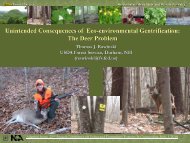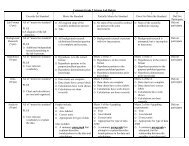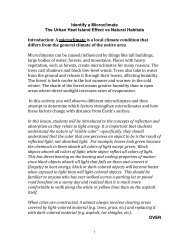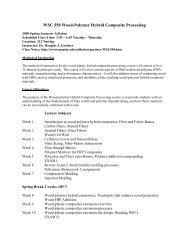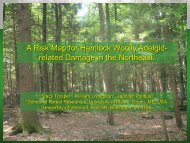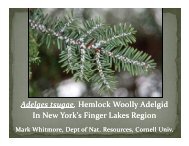Syllabus - School of Forest Resources - University of Maine
Syllabus - School of Forest Resources - University of Maine
Syllabus - School of Forest Resources - University of Maine
You also want an ePaper? Increase the reach of your titles
YUMPU automatically turns print PDFs into web optimized ePapers that Google loves.
Spring 2013<br />
SFR 402: Advanced <strong>Forest</strong> Measurements and Models<br />
Time and Place: Lecture: 10:00 to 10:50 AM, Mon. & Wed.; Nutting Hall 102<br />
Lab: 1:00 to 3:00 PM, Thurs.; Nutting Hall 239<br />
Instructor: Aaron Weiskittel Office hours: 2:30 -4:30 PM, Mon & Wed<br />
B.S. in Natural <strong>Resources</strong> (Ohio State <strong>University</strong>)<br />
M.S. & Ph.D. in <strong>Forest</strong>ry (Oregon State <strong>University</strong>)<br />
Nutting Hall 229<br />
aaron.weiskittel@maine.edu<br />
581.2857<br />
TA: Alisha Autio (alisha_autio@umit.maine.edu)<br />
Prerequisites: SFR 205<br />
Textbooks: Iles, K. 2003. A Sampler <strong>of</strong> Inventory Topics . Island Press. 869 p. (Required:<br />
Available from Dr. Weiskittel or http://www.island.net/~kiles/)<br />
A. Course Description and Rationale:<br />
Husch, B., Beers, T.W., and Kershaw, J.A., Jr. 2003. <strong>Forest</strong> Mensuration. 4 th<br />
edition. John Wiley & Sons. 443 p. (Required; Available at U<strong>Maine</strong> bookstore)<br />
Weiskittel, A.R., Hann, D.W., Kershaw, J.A., Vanclay, J.K., 2011. <strong>Forest</strong> growth<br />
and yield modeling. John Wiley & Sons, West Sussex, UK, p. 411. (Optional;<br />
Available at U<strong>Maine</strong> bookstore and individual chapters will be posted online)<br />
SFR 402 (3) is a continuation <strong>of</strong> the topics introduced in SFR 205. The course encompasses methods used<br />
to measure log, tree, stand, and forest-level attributes. A key component <strong>of</strong> the course is learning how<br />
to sample and analyze forest resources data.<br />
To manage forest resources sustainably, practitioners must know the quality and quantity <strong>of</strong> resources<br />
and how they change over time. <strong>Forest</strong> mensuration provides information that support forest<br />
management decisions at the stand and forest levels. Although the general topic <strong>of</strong> the course focuses<br />
on quantitative analysis <strong>of</strong> forest vegetation, we will spend considerable time and effort on measuring<br />
other forest resources (e.g., wildlife habitat resources and riparian zones). Moreover, the theory and<br />
methodology discussed in this course can be applied to other renewable resources.<br />
B. Course Structure and Organization:<br />
The instructor assumes that you have successfully completed the prerequisite courses listed above. If<br />
you have not completed these courses, please notify the course instructor at the beginning <strong>of</strong> the term.<br />
SFR 402 is a lecture-lab course with two 50-minute lectures and one 3-hour lab per week.<br />
The course will have both theoretical and practical components, with major emphasis on application <strong>of</strong><br />
various quantitative techniques to solve mensurational problems. Topics are presented both in class and
lab sessions. The lab section focuses on learning how to use Micros<strong>of</strong>t Excel as well as various sampling<br />
methods used to obtain and analyze tree, stand and forest-level data.<br />
C. Course Objectives<br />
The overall objective <strong>of</strong> this course is to understand the principles, concepts, and methods used for log,<br />
tree, stand, and forest-level measurements that support management decisions. Also, students will<br />
learn practical skills for both <strong>of</strong>fice and field settings.<br />
D. Course Outcomes<br />
After completing the course, you will:<br />
1. develop skills necessary to measure, acquire, analyze, and describe mensurational data and<br />
interpret resulting information;<br />
2. understand mathematical, statistical, and mensurational principles for designing and applying<br />
measurement and sampling protocols;<br />
3. be familiar with commonly used instruments and techniques for log, tree, stand, and forest level<br />
measurements; and<br />
4. master conventional timber cruising and log scaling skills, as well as other techniques for<br />
measuring attributes needed for ecosystem management.<br />
5. be able to use Micros<strong>of</strong>t Access to display, analyze, and summarize data<br />
E. Course Topics and Schedule<br />
Week Date Lecture Lab<br />
1 Jan 14 Course Introduction<br />
Introduction to using<br />
Micros<strong>of</strong>t Access<br />
Review <strong>of</strong> Statistical Principles and<br />
Techniques<br />
(Nutting 239)<br />
2 Jan 21 Martin Luther King Day (no class)<br />
Basic Tree-Level Measurements<br />
Statistics in Access<br />
(Nutting 239)<br />
3 Jan 28 Tree form and volume<br />
Estimate tree volume<br />
and develop local<br />
Volume tables<br />
volume tables<br />
(Nutting 239<br />
4 Feb 4 Tree Growth<br />
Log Scaling and Rules; Cord Scaling/Cull<br />
Estimation<br />
2<br />
Tree Growth; Log<br />
Scaling and Rules<br />
(Nutting 239)<br />
Reading<br />
Required Supplemental<br />
Iles; p. 21-61 Husch; p. 28-<br />
52<br />
Iles; p. 114 -<br />
125, 135-139<br />
Husch; p. 110-<br />
113, 118-150<br />
Iles; p. 141-<br />
144<br />
Husch; p. 201-<br />
227<br />
Husch; 81-92,<br />
99-110, 113-<br />
117<br />
Iles; 125-128<br />
Husch; p.<br />
359-376<br />
Iles; p. 111-<br />
113
Week Date Lecture Lab<br />
5 Feb 11 Stand attributes: Species Composition<br />
and Density<br />
Stand attributes: Site quality and site<br />
index<br />
6 Feb 18 Stand growth and stand table projection<br />
7 Feb 25 Review<br />
Growth and yield models/Stand<br />
Visualization<br />
Exam<br />
8 Mar 18 Introduction to sampling<br />
9 Mar 25<br />
Sample size<br />
Sampling the forest<br />
10 Apr 1<br />
Fixed radius sampling<br />
Variable radius sampling<br />
11 Apr 8<br />
Variable radius sampling (continued)<br />
3-P sampling<br />
12 Apr 15<br />
Stratified sampling<br />
Regeneration Sampling<br />
Sampling with Lines<br />
13 Apr 22 Growth estimation and monitoring<br />
14 Apr 29 Course Review<br />
FINAL May 6 (10:30<br />
am – 12:30 PM)<br />
Measurements and the real world<br />
3<br />
Calculating stand<br />
density and species<br />
composition (Nutting<br />
239)<br />
Site Index; Stand<br />
summaries and table<br />
projection<br />
(Nutting 239)<br />
Growth models<br />
(Nutting 239)<br />
Dealing with a large<br />
forest inventories<br />
(Nutting 239)<br />
Reading<br />
Required Supplemental<br />
2 book Iles; p. 128chapters<br />
135; Husch; p.<br />
available 162-169, 174online<br />
177, 178-181,<br />
188-190, 193-<br />
200<br />
2 book Husch; p.<br />
chapters 377-397<br />
available<br />
online Husch; p.<br />
397-401<br />
- -<br />
Iles; p. 151-<br />
195, p196-250<br />
Variable radius plot Iles; p. 332-<br />
360, 360-363<br />
Horizontal line<br />
sampling<br />
Iles; p. 490-<br />
567, 638-640<br />
3-P Iles; p. 431-<br />
478, 284-328<br />
Field exercise Husch; p. 238-<br />
241<br />
Iles; p. 378-<br />
422<br />
Field exercise Iles; p. 660-<br />
685<br />
Field exercise - -<br />
<strong>Maine</strong> Day (no class)<br />
Final Project Presentation - - -<br />
Husch; p.<br />
258-261<br />
Husch; p.261-<br />
265<br />
Husch; p.<br />
272-282<br />
Husch; p.355-<br />
358, 316-320<br />
Husch; p.<br />
241-248<br />
Husch; p.<br />
334-336
F. Grading Plan:<br />
Grading will be based on eleven weekly laboratory assignments, an oral presentation, and field<br />
performance, one-midterm exam, and a final project. All laboratory assignments will have the same<br />
weight and will be graded on a percentile basis. The relative weights <strong>of</strong> the course components are:<br />
Lab reports (11) and field performance 35%<br />
Midterm Exam 25%<br />
Final Project 20%<br />
Participation 15%<br />
Oral presentation 5%<br />
Lab reports, oral presentation, and field performance<br />
Lab reports are due 1 week after they are assigned. Late lab reports will not be accepted.<br />
For field labs, the relevant maps and descriptions <strong>of</strong> the labs will be handed out prior to each lab<br />
session. Field procedures will be explained at the start <strong>of</strong> each lab session. Laboratory exercises will be<br />
conducted in crews <strong>of</strong> three or four students each. For each lab, crews will work independently, applying<br />
the knowledge acquired in lectures and labs.<br />
The final field exercise will involve using the skills developed in this course to inventory a ~5 acre stand<br />
and report the results orally and in a written report. The stand can be selected by the group. A stand<br />
will be made available if desired.<br />
Exam<br />
One midterm exam will be given during the semester (February 27, 2013). The exam will be open book<br />
and will involve an array <strong>of</strong> formats including multiple choice, short answer, and essay. The questions<br />
will come from both the lecture and textbook.<br />
Final Project<br />
In lieu <strong>of</strong> a final exam, a final project will be turned in and presented on the date <strong>of</strong> the scheduled final<br />
exam (May 6, 2013). The final project will involve summarizing the stand inventory, assessing the<br />
performance <strong>of</strong> the selected sampling scheme and intensity, and recommendations for future<br />
inventories. This project will be three to five pages in length and include Introduction, Methods, Results,<br />
and Discussion sections. More information will made available later in the term.<br />
G. Availability <strong>of</strong> Course Materials<br />
All course materials will be made available on Blackboard (https://www.courses.maine.edu). You will be<br />
required to enter your <strong>University</strong> <strong>of</strong> <strong>Maine</strong> System user name and password to gain access to the site.<br />
H. Accommodations for Students with Disabilities<br />
If you need course adaptations or accommodations because <strong>of</strong> a disability, please contact Disability<br />
Support Services (East Annex, 581.2319).<br />
4
I. Student Code <strong>of</strong> Conduct<br />
<strong>School</strong> <strong>of</strong> <strong>Forest</strong> Resource students must adhere to the <strong>University</strong> <strong>of</strong> <strong>Maine</strong> Student Conduct Code. Each<br />
student is expected to work independently on all exams, including take home exams. Students may<br />
neither give nor receive any assistance on examinations. All written material, including homework, term<br />
papers, reports, etc., must be the student’s original work. The bounds <strong>of</strong> original work and the degree <strong>of</strong><br />
collaboration that will be allowed in this course will be established by the pr<strong>of</strong>essor. The work(s) <strong>of</strong><br />
others may only be used with proper reference or acknowledgment. Failure to adhere to this policy can<br />
result in the receipt <strong>of</strong> a failing grade, suspension, or dismissal from the <strong>University</strong>. Official <strong>University</strong><br />
Policy: No tuition refunds will be allowed for dropped courses after the second week <strong>of</strong> class unless very<br />
extraordinarily extenuating circumstances exist.<br />
J. Attendance Policy<br />
Attendance is expected at all lectures and required at all laboratories. Students missing laboratories for<br />
a good reason should notify the instructor or Graduate Teaching Assistant prior to lab to arrange an<br />
alternate assignment. Failure to do so will result in a zero for that exercise. Three missed labs will result<br />
in an L grade for the course (a failure for nonattendance).<br />
K. Grading Policy<br />
Grades will be assigned as follows:<br />
90 - 100 A<br />
80 - 89 B<br />
70 - 79 C<br />
60 - 69 D<br />
Below 60 E<br />
Plus/Minus grading may be used if warranted. Late assignments will lose 10% each day past the due<br />
date unless the Instructor or Graduate Teaching Assistant is notified prior. Students will only be excused<br />
from an exam in only two situations: (1) preapproved absence for medical reasons and (2) emergency<br />
medical absence.<br />
L. H1N1<br />
In the event <strong>of</strong> disruption <strong>of</strong> normal classroom activities due to an H1N1 swine flu outbreak, the<br />
format for this course may be modified to enable completion <strong>of</strong> the course. In that event, you will<br />
be provided an addendum to this syllabus that will supersede this version.<br />
M. Competencies<br />
The following are specific skills that one should have after completing this course:<br />
1. Calculate the volume <strong>of</strong> an individual tree using a volume table, equation, and stem analysis<br />
measurements<br />
2. Use volume estimates and wood density to predict carbon content in tree stems<br />
3. Collect data for estimating stand parameters using fixed area plots<br />
5
4. Collect data for estimating stand parameters using variable radius sampling<br />
5. Collect data for estimating stand parameters using 3-P sampling<br />
6. Demonstrate how to estimate species composition on the basis <strong>of</strong> stand density, basal area, and<br />
volume<br />
7. Develop appropriate histograms to show species composition<br />
8. Estimate arithmetic and quadratic mean from a given set <strong>of</strong> tree measurements<br />
9. Estimate a basal area-weighted mean tree height from a given set <strong>of</strong> variable radius sampling<br />
data<br />
10. Develop an appropriate stand and stock table from fixed area plot measurements<br />
11. Develop an appropriate stand and stock table from variable radius sampling data<br />
12. Understand how individual tree growth models like FVS function<br />
13. Estimate average stocking or density from a regeneration survey<br />
14. Use increment data to develop a stand table projection system<br />
15. Use stand tables projections to forecast stand volume and value growth<br />
16. Calculate the minimum number <strong>of</strong> samples to achieve a desired level <strong>of</strong> statistical precision<br />
17. Use Access to conduct basic data calculations and conversions<br />
18. Use Access to conduct basic statistical analyses<br />
19. Use Access to summarize tree lists<br />
20. Use Access graphics to develop an appropriate display data and fit a regression model<br />
21. Summarize data into meaningful report with appropriately titled tables and graphs<br />
6
N. Course Concept Map<br />
Tree diameter,<br />
height, crown, and<br />
growth<br />
Lab 1: Using Access<br />
Log grading &<br />
scaling<br />
Tree and Stand<br />
Measurements<br />
Density, stocking,<br />
DBH distribution,<br />
and Volume<br />
Lab 2: Descriptive &<br />
Inferential Statistics Lab 3: Tree and<br />
Stand Volume<br />
<strong>Forest</strong><br />
Measurements<br />
& Modeling<br />
Statistics Sampling Designs<br />
Descriptive Inferential Simple Random Systematic<br />
Lab 4: Tree growth<br />
and log scaling<br />
Lab 5: Stand density<br />
and composition<br />
Final Project<br />
7<br />
Lab 6: Stand table<br />
projection<br />
Lab 9: Fixed area<br />
plots<br />
Lab 7: Using growth<br />
models<br />
Lab 10: Variable<br />
radius plots<br />
Variable Selection<br />
Probability<br />
Lab 8: Summarizing<br />
forest inventory<br />
data<br />
INDOOR<br />
Stratified<br />
Lab 11: 3P sampling<br />
OUTDOOR
SFR 107: <strong>Forest</strong><br />
Vegetation<br />
SFR 407: <strong>Forest</strong><br />
Ecology<br />
SFR 200: Summer<br />
Camp I<br />
SFR 402: Advanced<br />
Measurements<br />
SFR 477: <strong>Forest</strong><br />
Landscape<br />
Management &<br />
Planning<br />
SFR 489: Capstone<br />
Project<br />
8<br />
SFR 105: <strong>Forest</strong><br />
Measurements &<br />
Statistics<br />
SFR 408/409:<br />
Silviculture<br />
SFR 300: Summer<br />
Camp II




